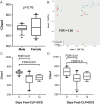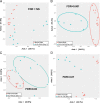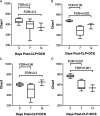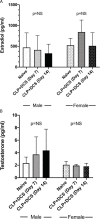Sex differences associate with late microbiome alterations after murine surgical sepsis
- PMID: 35324554
- PMCID: PMC9323556
- DOI: 10.1097/TA.0000000000003599
Sex differences associate with late microbiome alterations after murine surgical sepsis
Abstract
Background: Sepsis-induced gut microbiome alterations contribute to sepsis-related morbidity and mortality. Given evidence for improved postsepsis outcomes in females compared with males, we hypothesized that female mice maintain microbiota resilience versus males.
Methods: Mixed-sex C57BL/6 mice underwent cecal ligation and puncture (CLP) with antibiotics, saline resuscitation, and daily chronic stress and were compared with naive (nonsepsis/no antibiotics) controls. For this work, the results of young (3-5 months) and old (18-22 months) adult mice were analyzed by sex, independent and dependent of age. Mice were sacrificed at days 7 and 14, and 16S rRNA gene sequencing was performed on fecal bacterial DNA. α and β diversity were determined by Shannon index and Bray-Curtis with principal coordinate analysis, respectively. False discovery rate (FDR) correction was implemented to account for potential housing effect.
Results: In control mice, there was no difference in α or β diversity between male and female mice (FDR, 0.76 and 0.99, respectively). However, male mice that underwent CLP with daily chronic stress had a decrease in microbiota α diversity at 7 days post-CLP (Shannon FDR, 0.005), which was sustained at 14 days post-CLP (Shannon FDR, 0.001), compared with baseline. In addition, male mice maintained differences in β diversity even at day 14 compared with controls (FDR, <0.0001). In contrast, female mice had a decreased microbiota α diversity (Shannon FDR, 0.03) and β diversity (FDR, 0.02) 7 days post-CLP but recovered their α and β diversity by post-CLP day 14 (Shannon FDR, 0.5, and FDR, 0.02, respectively). Further analysis of females revealed that only young female mice were not different (β diversity) post-CLP day 14 to controls.
Conclusion: Although sepsis-induced perturbations of the intestinal microbiota occur initially in both male and female C57BL/6 mice, females demonstrate different microbiota by day 14. This may be seen primarily in younger females. This difference in recovery may play a role in outcome differences between sexes after sepsis.
Copyright © 2022 The Author(s). Published by Wolters Kluwer Health, Inc. on behalf of the American Association for the Surgery of Trauma.
Figures






Similar articles
-
Septic Stability? Gut Microbiota in Young Adult Mice Maintains Overall Stability After Sepsis Compared to Old Adult Mice.Shock. 2021 Apr 1;55(4):519-525. doi: 10.1097/SHK.0000000000001648. Shock. 2021. PMID: 32826817 Free PMC article.
-
[Composition and changes of intestinal flora in septic mouse model].Zhonghua Wei Zhong Bing Ji Jiu Yi Xue. 2021 Jan;33(1):10-16. doi: 10.3760/cma.j.cn121430-20200814-00579. Zhonghua Wei Zhong Bing Ji Jiu Yi Xue. 2021. PMID: 33565393 Chinese.
-
Exercise training modifies gut microbiota with attenuated host responses to sepsis in wild-type mice.FASEB J. 2019 Apr;33(4):5772-5781. doi: 10.1096/fj.201802481R. Epub 2019 Jan 31. FASEB J. 2019. PMID: 30702933
-
[Analysis of the changes in intestinal microecology in the early stage of sepsis rat based on 16S rDNA sequencing].Zhonghua Wei Zhong Bing Ji Jiu Yi Xue. 2022 Jan;34(1):28-34. doi: 10.3760/cma.j.cn121430-20201215-00754. Zhonghua Wei Zhong Bing Ji Jiu Yi Xue. 2022. PMID: 35307057 Chinese.
-
[Regulatory effects of umbilical cord mesenchymal stem cells and their conditioned medium on gut microbiota of septic mice].Zhonghua Wei Zhong Bing Ji Jiu Yi Xue. 2023 Jan;35(1):43-50. doi: 10.3760/cma.j.cn121430-20221201-01049. Zhonghua Wei Zhong Bing Ji Jiu Yi Xue. 2023. PMID: 36880237 Chinese.
Cited by
-
Targeting sting to reduce sepsis-induced acute intestinal injury.Surgery. 2023 Oct;174(4):1071-1077. doi: 10.1016/j.surg.2023.06.032. Epub 2023 Jul 29. Surgery. 2023. PMID: 37517896 Free PMC article.
-
Acute emergence of the intestinal pathobiome after postinjury pneumonia.J Trauma Acute Care Surg. 2024 Jul 1;97(1):65-72. doi: 10.1097/TA.0000000000004300. Epub 2024 Mar 14. J Trauma Acute Care Surg. 2024. PMID: 38480488 Free PMC article.
-
Sex, sepsis and the brain: defining the role of sexual dimorphism on neurocognitive outcomes after infection.Clin Sci (Lond). 2023 Jun 28;137(12):963-978. doi: 10.1042/CS20220555. Clin Sci (Lond). 2023. PMID: 37337946 Free PMC article. Review.
-
Persistence and Sexual Dimorphism of Gut Dysbiosis and Pathobiome after Sepsis and Trauma.Ann Surg. 2024 Sep 1;280(3):491-503. doi: 10.1097/SLA.0000000000006385. Epub 2024 Jun 12. Ann Surg. 2024. PMID: 38864230
-
Nonselective beta blockade enhances gut microbiome diversity in a rodent model of trauma, hemorrhage, and chronic stress.J Trauma Acute Care Surg. 2025 Feb 1;98(2):309-318. doi: 10.1097/TA.0000000000004461. Epub 2024 Nov 13. J Trauma Acute Care Surg. 2025. PMID: 39813154
References
-
- Gaieski DF, Edwards JM, Kallan MJ, Carr BG. Benchmarking the incidence and mortality of severe sepsis in the United States. Crit Care Med. 2013;41(5):1167–1174. - PubMed
-
- World Health Organization . Editor improving the prevention, diagnosis and clinical management of sepsis (WHA 70.7). Geneva, Switzerland: Seventieth World Health Assembly; 2017.
-
- Torio CM, Moore BJ. National Inpatient Hospital Costs: The Most Expensive Conditions by Payer, 2013: Statistical Brief #204. Healthcare Cost and Utilization Project (HCUP) Statistical Briefs [Internet]. Rockville, MD: Agency for Healthcare Research and Quality (US); 2016. - PubMed
Publication types
MeSH terms
Substances
Grants and funding
LinkOut - more resources
Full Text Sources
Medical
Miscellaneous

